-
EngineTwin-Turbo 6.0L V12
-
Power720 HP / 738 LB-FT
-
Transmission7-Speed SCT
-
0-60 Time3.0 Seconds (est)
-
Top Speed224 MPH
-
DrivetrainRear-Wheel Drive
-
Curb Weight2,950 LBS
-
Seating2
-
As Tested Price$1,840,000
My default condition as a law-abiding citizen is to typically play it safe to avoid incarceration, yet I think that part of my personality leapt out of my moving car a few miles back. My residual self has been left with an overwhelming urge to mash the Huayra's beautifully sculpted alloy accelerator pedal and hold on as a twin-turbocharged V12 releases its fury. I long to be molded into the seat as 730 horsepower turns the loathed, congested 405 freeway ahead of me into a blur. The urge to launch this carbon-fiber coupe clear into the next county at hyperspeed – regardless of any legal or life-threatening penalties – is terrifyingly overpowering.
Wisely, I've got a passenger belted next to me whose shirt is embroidered with a Pagani logo. The gentleman comes with the car and assumes the role of babysitter, technical expert, therapist and counselor – trained to preserve both the $1.84-million hypercar and my driver's license.

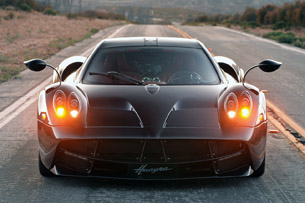
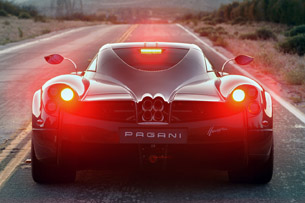
Seventeen minutes earlier, I had arrived at The Auto Gallery in Calabasas to meet the Pagani Huayra. The unpainted coupe – nothing but clear resin over meticulously layered carbon-fiber – stood parked in the driveway of the dealership, surrounded by a camera-wielding crowd of gawkers. Its front hood was tilted forward, its back deck propped rearward and both of its gullwing doors were raised high, like a suspect facing imminent arrest. Its physical appearance, even in such a vulnerable pose, was nothing short of spectacular.The attention to detail on view is astounding, and examining the craftsmanship inside and out is enough to leave one exhausted.
Well-read enthusiasts know the history of the Huayra, Horacio Pagani's followup to his giant-killing Zonda. Launched to the world at the Geneva Motor Show in 2011, its arrival aimed to raise the bar in every measurable automotive category. Its construction showmanship includes a lightweight chassis boasting a central monocoque made of titanium-infused carbon-fiber. Every one of its featherweight components, a hand-crafted assemblage of carbon-fiber, titanium, aluminum and other exotic alloys, is either bonded, riveted or bolted together with one of 1,400 titanium fasteners, each engraved with a Pagani logo.
The attention to detail on view is astounding, and examining the craftsmanship inside and out is enough to leave one exhausted. I stare, I swoon and I swear. It doesn't take even casual bystanders long to realize that there are less impressive works on display at the Louvre.
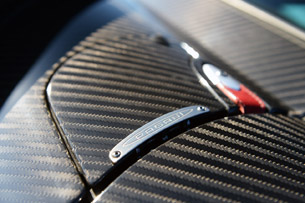
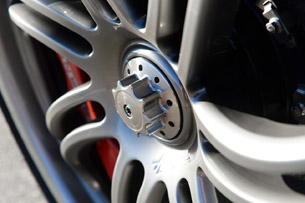
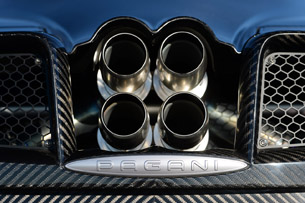
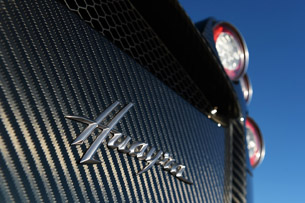
Climbing into the Huayra is an exercise, but not a chore. The carbon-fiber sill is wide, but both doors swing high and take a good slice of the roof with them, so headroom is unlimited. Unfortunately, closing the doors from a seated position takes a bit of a stretch, so grabbing the handle before settling into the bucket is most efficient. Unlike some V12-powered mid-engined supercars that compromise cabin space for those over six-feet tall (the Lamborghini Aventador comes immediately to mind), the Pagani is unexpectedly comfortable and roomy for my shoulders, torso and legs. The tinted panel overhead allows plenty of light to spill into the cabin, but it also raises concerns about excessive cabin heat – I had that very issue with a similar glass roof in the Bugatti Veyron.The cabin is flamboyant, with lots of bright eye candy and minute contrasting details that tickle your inner geek.
The cabin is flamboyant, for lack of a better word, with lots of bright eye candy and minute contrasting details that tickle your inner geek. You'll want to sit for about five minutes just to take it all in. The flat-bottom, carbon-fiber steering wheel is optimally placed, with meaty leather grips for the hands and thick, raised stitching that you can feel with your fingertips. There are no turn signal stalks, as that pedestrian task is assigned to individual aluminum buttons on the wheel's spokes. It's the same story for the headlights and wipers – both controlled by cone-shaped aluminum knobs on the steering wheel. The horn buttons are embedded in the leather rim of the wheel.
Primary instrumentation includes a round tachometer and speedometer dial set on either side of a small, flat multi-function display. There are other smaller dials set below the primary gauges. Everything is brightly polished metal. Overall, the contrast on the gauges is rather lousy, especially during the day while wearing sunglasses (at night, the dash is illuminated with a rainbow's choice of colors). The secondary controls on the center stack, are all bright metalwork, too. Each is beautifully polished, delicately executed and pretty to look at, but the Pagani doesn't have much to brag about in terms of sensible ergonomics.
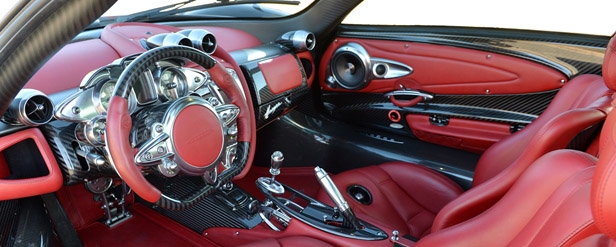
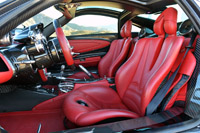
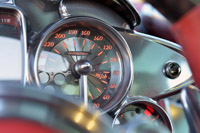
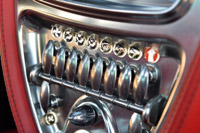
Doors shut, seatbelt snug and mirrors adjusted, I insert the oversized car-shaped key in the lower console and bring the Huayra's V12 to life. The engine drops down to a smooth rumble and the air conditioning system begins to pump out an arctic blast (concerns about the tinted roof overhead were warrantless – the climate control system works so well that I found myself constantly turning down the fan speed – a pleasant surprise).Driving a borrowed car that costs $1.84 million on public roads is absolutely terrifying.
Driving a borrowed car that costs $1.84 million on public roads is absolutely terrifying, as everything within eyesight is an exaggerated threat to its well-being – and my employment. The tractor trailer dropping gravel, the teenage girl texting while driving and the motorcycle rider splitting lanes are each capable of causing hundreds of thousands of dollars in damage in the blink of an eye.
Outward visibility, always a dilemma when piloting a closed-roof supercar, isn't bad at all. There's good visibility to the front and sides, and even the rear. Of course, there's a big blind spot over each shoulder, but those trick exterior mirrors, which hang in space at the end of delicate carbon-fiber wings on each front quarter panel, are exceptionally placed. I want them on my daily driver, but they might just cost as much as my car.
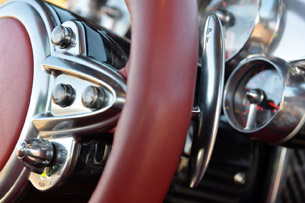
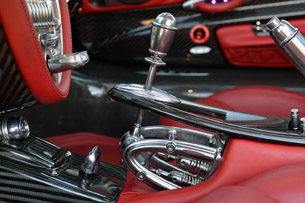
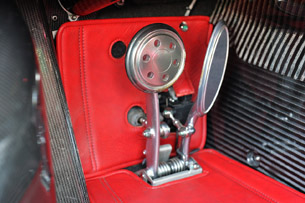
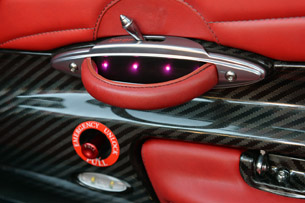
Stuck in the congested LA Basin, I drive the Huayra like a Honda, crawling onto the crowded 405 en route to more open pastures, the expansive mountains and deserts of Southern California. Temperatures will be high, but the roads will be barren.The Huayra's suspension is nothing short of race-spec componentry slightly detuned for street use.
Somehow, I avoid incidents on the 405 and squash the desire to go lawless long enough to make it to the base of Big Tujunga Road. The famed canyon route offers a scenic and lightly traveled climb over the San Gabriel Mountains. I've been in the Pagani about 30 minutes, and all of it has been stuck in a pack of cars at 60 miles per hour – this is my first opportunity to actually try more than 15 degrees of steering input and give the exotic more than five percent of throttle travel.
The Huayra's suspension is nothing short of race-spec componentry slightly detuned for street use. Raising the front or rear bodywork exposes double-wishbones and pushrod-actuated Ohlins dampers – most of the parts are anodized gold, making them even more striking. Light, strong and stunning, these miniature works of art are formed out of Avional, an aluminum alloy rich in copper.
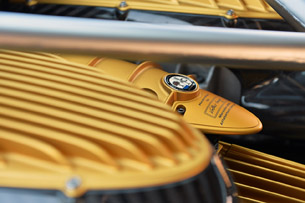
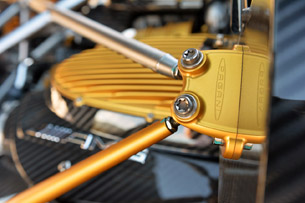
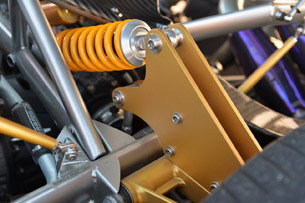
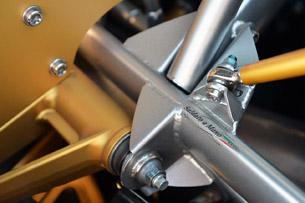
But wait, there's more. The Huayra is fitted with an automatic hydropneumatic front suspension jack that continuously raises and lowers the nose to vary the its angle of attack – like a jet fighter. Its aircraft-like maneuverability is further improved with four independent movable ailerons, one at each corner, which come to life at speeds above 50 mph. Controlled by a computer that monitors vehicle speed, steering input and lateral g-forces, their objective is to reduce lift and increase downforce in corners. They also raise in dramatic fashion under braking to act as air brakes.A firm foot on the accelerator initiates a guttural sucking noise, followed by a wallop of forward thrust that feels like a solid rocket booster has been lit.
The Huayra's ride on the freeway is best described as aggressively firm – not abusive. Most of the commotion is from the absurdly oversized contact patches. To ensure the Pagani stays planted, engineers have fitted sticky Pirelli P-Zero rubber at all four corners (255/35YR19 front and 335/30YR20 rear). The tires are mounted on ultra-lightweight forged alloy wheels, and they beat like drums on the LA pavement.
Free of the congestion and gawking motorists who have been dangerously snapping photographs as they drive, I make my way to the base of the mountain, where I finally have the opportunity to open her up.
The twin-turbocharged 6.0-liter V12, sourced from Mercedes-Benz, develops 720 horsepower and 738 pound-feet of torque all-in. That's enough thrust to launch the 2,950-pound Pagani Huayra from a standstill to illegal velocities in under three seconds. A firm foot on the accelerator initiates a guttural sucking noise that originates just aft of each side window at the air intake port, followed by a wallop of forward thrust that feels like a solid rocket booster has been lit. I hold on, admittedly a bit panicked, for a few seconds before easing off.
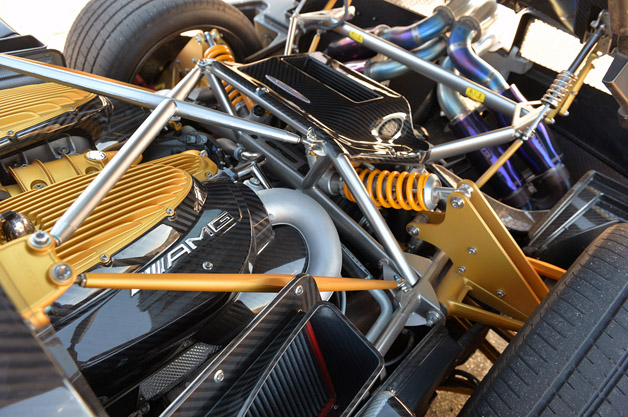
Aggressively diving into the first corner, it's impossible not to be struck by how balanced the Huayra feels. Add up the aforementioned technical wizardry applied to keeping the chassis level and controlled during cornering, and it's no wonder body roll is virtually nonexistent. There is no pitch under acceleration or dive during deceleration, it's absolutely dead stable. Similarly, the steering offers a perfect amount of resistance, feedback and vibration. It might just be flawless.The steering offers a perfect amount of resistance, feedback and vibration. It might just be flawless.
Fear diminishes with each subsequent corner as I bond man-to-machine with the Huayra. Right hander, straight, left hander, straight – it responds obediently to each input. The carbon-fiber sculpture feels as if it has big shoulders, undeniably wide and low, but not particularly long in overall dimension. Unexpectedly, and unlike many of its peers, I'd call this car easy to drive.
I so want to hear the sound of the V12 at full boil, but its wail is strangely inaudible from within the cabin. Instead, the overpowering noise is an angry whoosh provided by the intakes. Their sucking sound is implausibly loud. Deafening, really – as if the smooth pipes are located on the seatbacks themselves. Once you realize you won't be sucked into the AMG-crafted engine, you can start to enjoy it.
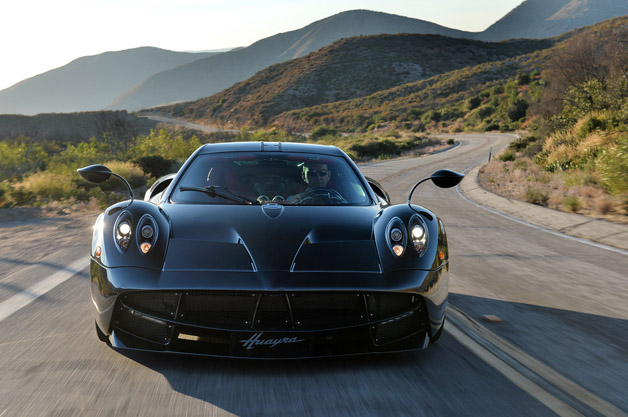
To accommodate a reported top speed of 224 mph and all of the stress and trauma that comes with such velocities, the brakes are carbon-ceramics at all four corners (six-piston calipers up front, four-piston calipers in the rear). They work unquestionably well, bringing the Pagani down from speed without any sign of fade or distress. More impressive are the forward ailerons, which stand tall to salute the driver each time you slam down the brake pedal – they look so damn cool that you'll find yourself hitting the brakes just to watch them dance.The handling, steering and braking are superb, but you'll find yourself making concessions for the gearbox.
Those active ailerons are a tireless quartet, flapping up and down each time you force the Pagani into a hot bend or jump on its brakes. You see them out the front windshield, and you catch a glimpse of them in the rearview mirror. I've experienced active aero before, but there's something a bit more magical about these carbon fiber panels – enter a corner at speed, hit its apex just right and they display an artful choreographed ballet that borders on the hypnotic.
The handling, steering and braking are superb, but you'll find yourself making concessions for the gearbox. The seven-speed automated manual gearbox, mounted transversely behind the differential to allow the engine to be placed closer to the rear wheels, is a single-clutch design. It saves a reported 200 pounds over a suitable dual-clutch unit, but its mass savings don't offset the fact that it comes off as slow, clunky, temperamental and restless. To reduce the likelihood of its angry mannerisms damaging your vertebrae, it's best to forgo automatic mode and shift via paddle only after lifting briefly between shifts. Full-throttle gearchanges are quick but shocking, best described as merciless. (My Pagani minder claimed the gearbox in my test car was behaving badly, as it needed servicing).
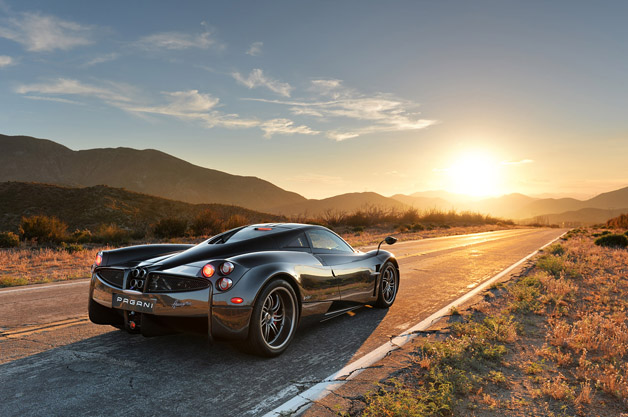
Seat time in the Huayra is distinctive – unique among other supercars. Ferrari, McLaren, Lamborghini, Bugatti and Porsche all coerce the driver into becoming part of a perfectly polished instrument, surrounding the fortunate operator with a delicious exhaust note that makes them feel part of the vehicle. The Pagani, on the other hand, has an exhilarating sharp edge to it that never allows you to drop your guard. I was constantly nervous, relentlessly cautious and overwhelmingly engaged. The exhaust note is so distant that the driver feels perched at the nose, as if mounted on the tip of a rocket ship with unlimited thrust on tap. It's hard not to be mesmerized by this fascinating, imperfect machine – the driving experience is intoxicating.The Pagani has an exhilarating sharp edge to it that never allows you to drop your guard.
Late in the afternoon, after many wondrous hours in its leather saddle, I round a corner to see a straight desert road stretching far in front of me. The scene is surreal, with the warm sun at my back and a desolate, perfectly flat paved surface beaconing. Realizing a once-in-a-lifetime opportunity, I do what any warm-blooded automotive enthusiast would do while driving a Pagani Huayra – I bury the throttle.
The V12's vocal intakes take a deep breath, my cheeks stretch back to my earlobes and the world becomes a glorious blur. I may be going crazy, but euphoria is a welcome stop along the way.
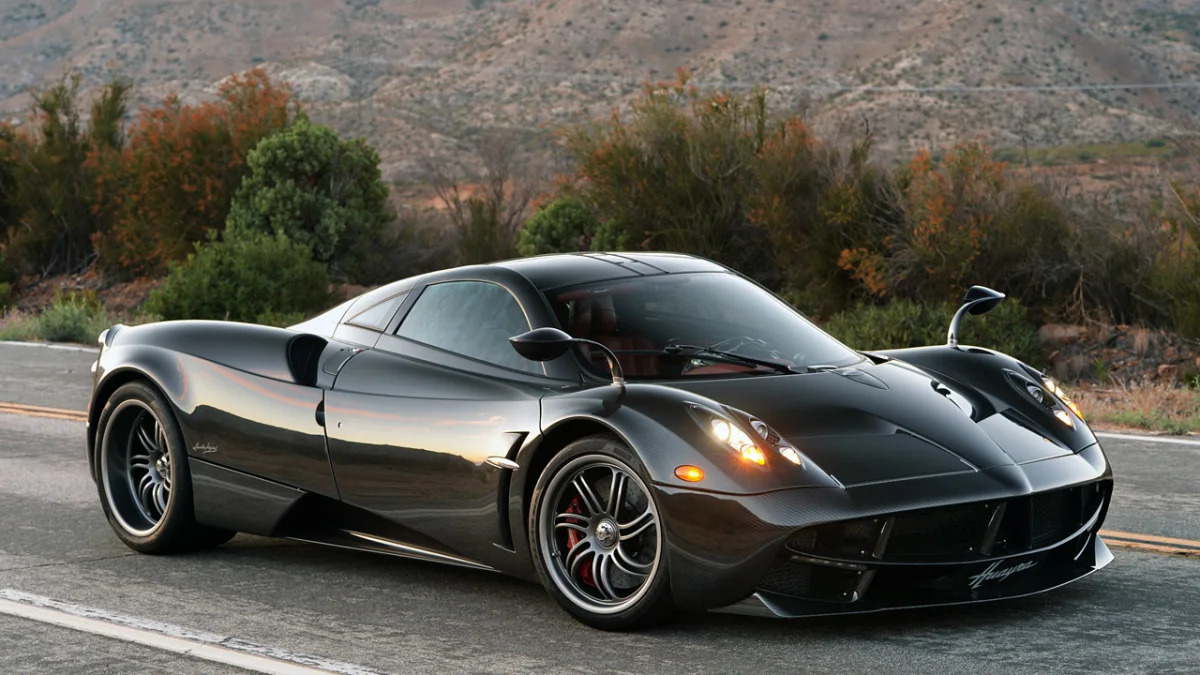









Sign in to post
Please sign in to leave a comment.
Continue